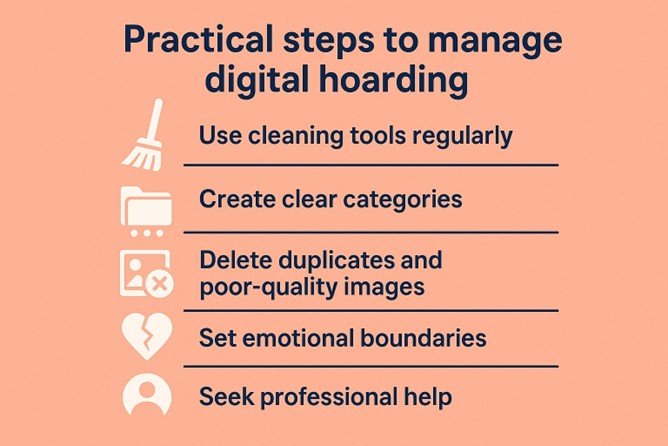Digital & Photo Hoarding: Should It Be
Classified as OCD

Many of us have smartphones or computers filled with thousands of photos, emails, or files that we just can’t bring ourselves to delete. Perhaps you’ve met someone whose inbox has tens of thousands of unread emails, or a friend who snaps pictures often and keeps every single one. Usually, saving files isn’t harmful. But when the stockpiling becomes extreme and causes stress, anxiety, or interferes with daily life, experts consider it problematic.
Is Digital Hoarding a Form of OCD?
Digital hoarding refers to the excessive accumulation of digital files (such as photos, videos, emails, documents) and an extreme difficulty in deleting or organizing them. If a person has a lot of pictures and full iPhone storage, it isn’t always a problem. Storage is cheap, and most people take thousands of pictures yearly. But digital hoarding becomes a mental health issue when it causes distress or disrupts daily life.
You might be wondering: isn’t hoarding just a type of OCD (obsessive-compulsive disorder)? Historically, hoarding was indeed considered a symptom or subtype of OCD. Many people with classic OCD do not hoard, but some do, and earlier editions of diagnostic manuals viewed compulsive hoarding as one possible manifestation of OCD. As research grew, experts found that compulsive hoarding often differs from typical OCD in important ways, though it’s still mainly considered to be an OCD-related disorder.
Now, how is digital hoarding disorder different from OCD in terms of why the person hoards? The main difference lies in the motivation and mindset. In hoarding disorder, people often hoard because they feel a strong emotional attachment to items or believe the items have utility or sentimental value, even if outsiders see them as junk. The distress comes when they contemplate getting rid of things; it “feels wrong” or like losing a part of themselves or abandoning something important.
Why Do People Hoard Digital Files?
Here are some common reasons people hoard digital items, broken down by OCD-related versus non-OCD motivations:
- OCD-related motivations come from specific anxieties or “what if” fears. For example, a photo hoarder might collect pictures because they fear that if they don’t document every moment, they will forget something important or lose their identity. They might keep every email due to an obsessive thought that if they delete the wrong one, a terrible consequence will occur. There can be a sense of catastrophic thinking e.g. “If I throw this file away, I’ll definitely need it and something bad will happen because I won’t have it”.
- Another OCD-related drive is the need for certainty and completeness. The person feels they must archive everything to be sure nothing is missing. In essence, digital hoarding is a way to alleviate a fear of uncertainty, loss, or harm. As noted, some OCD sufferers also hoard information to make sure they didn’t make a mistake or to be able to check later that nothing bad happened.
- Non-OCD motivations are more about attachment and utility without a singular catastrophic fear. Common reasons include: “I might need this later”, a belief that the digital file could be useful for future reference, so it feels imprudent to delete it. photos especially carry sentimental weight; people feel that deleting a photo of a loved one is like throwing away a precious memory.
- Another reason is seeing the collection of files as part of one’s identity or accomplishments. For instance, saving all your college assignments or work projects because they represent your hard work and you feel proud having them. There’s also a more general “fear of missing out” (FoMO) aspect: especially among younger people, there’s an urge to capture every moment (on social media, photos, etc.) so as not to miss out on documenting an experience.
It’s also worth noting that not all hoarding stems from a diagnosable disorder. Some people may simply have poor digital organization habits or procrastinate on cleaning their files, without severe distress.
How Common Is Digital Hoarding?
Digital hoarding may sound like a niche problem, but research is showing that a lot of people exhibit some degree of digital hoarding behaviors. In a study involving 2,204 Chinese college students, over 32% showed clear signs of digital hoarding behavior. And what do they hang onto the most? Photos. Out of all types of digital files, personal photos were the ones students hoarded the most (and were also the hardest for them to delete).
These statistics suggest that digital hoarding behaviors are quite common, though the severity can range from mild inconvenience to serious life disruption.
Treatment and Management Options for Electronic Hoarding
When pics obsession and fear of deleting files begin to cause distress, it’s important to take steps toward recovery. Therapists often recommend Cognitive Behavioral Therapy (CBT), which helps people challenge the beliefs that drive their photo anxiety. CBT can also reduce compulsive behaviors, such as constantly backing up OCD photos or feeling obsessed with taking pictures of yourself.
Practical steps to manage digital hoarding include:

- Use cleaning tools regularly. Try a free iPhone storage cleaning app to scan and organize your photo library or clear excess files. These apps help prevent overwhelming storage warnings and reduce digital clutter.
- Set time limits for sorting. Dedicate 10–15 minutes each week to review your files. Short, consistent sessions are more sustainable than occasional marathon cleanups. During these sessions, focus on deleting low-value files like old screenshots or irrelevant downloads, to maintain a manageable and calm digital space.
- Create clear categories. Divide work documents and personal photos into labeled folders to reduce clutter.
- Delete duplicates and poor-quality images. Many people unintentionally keep near-identical shots out of photo anxiety or perfectionism. Focus on the best images, the ones that truly capture memories to minimize photo obsession and make your storage more balanced.
- Set emotional boundaries. Remind yourself that deleting pictures doesn’t erase the experience they represent. Memories live in the mind, not in storage. This mindset helps reduce the attachment often seen in OCD photography or people obsessed with taking pictures of themselves.
- Seek professional help. If deleting files or photos causes severe anxiety, guilt, or distress, consider therapy focused on OCD or hoarding-related behaviors. Cognitive Behavioral Therapy (CBT) and exposure-based methods can help break the cycle of fear and attachment.
These practices can create a healthier relationship with your phone. Over time, small, steady actions transform overwhelming data collections into a cleaner, more organized space. In some cases, the best option is to combine therapy with practical clean-up routines. A therapist can help manage the emotional triggers behind hoarding, while tools like cleaners and digital organizers make daily maintenance easier.
Closing Note
Electronic hoarding can be seen as a modern version of traditional hoarding. While there is overlap, particularly when OCD-related symptoms are present, photo hoarding can also be a standalone issue driven by factors like fear of missing out. The exact classification is still under study.
What’s clear already is that digital hoarding can have a serious impact on daily life and mental health, even if the mess is hidden in bytes and folders rather than piled in living rooms. If people can recognize the signs of hoarding, they should seek appropriate help and perhaps learn to declutter their digital lives for their own well-being.